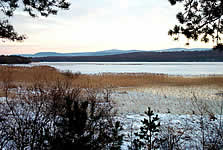Loch Davan is slowly undergoing a change in trophic status from mesotrophic (containing moderate levels of nutrients) to eutrophic (containing high levels of nutrients). Additionally, it is subject to increased rates of sedimentation.
Eutrophication can cause algal blooms. The reduction in light caused by the algal blooms results in the loss of submerged vegetation with subsequent effects on the fish that feed on the vegetation. Ultimately, the whole food chain is affected with the fish feeders, i.e., otter and osprey suffering from a reduction in prey abundance.
High rates of sedimentation create muddy waters which can affect mortality rates in larval fish and reduces available light to submerged vegetation; spawning habitat can also be lost. This is of particular concern along the Logie Burn with the loss of salmon redds and the potential impact this is having on salmon recruitment.
Factors identified as possibly contributing to these changes include:
- Diffuse agricultural run-off
- Domestic sewage inputs
- Seasonal influx of nutrients from roosting geese
- Changes in the loch’s characteristics and canalisation
- Forestry run-off
- Upland management.




